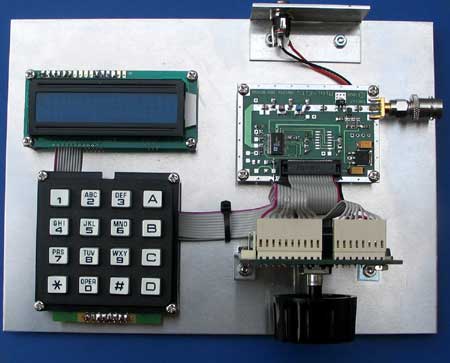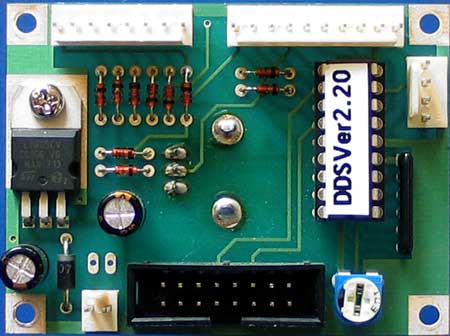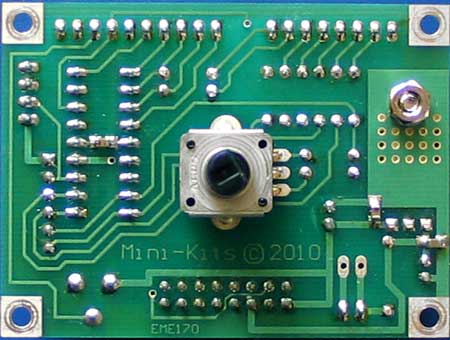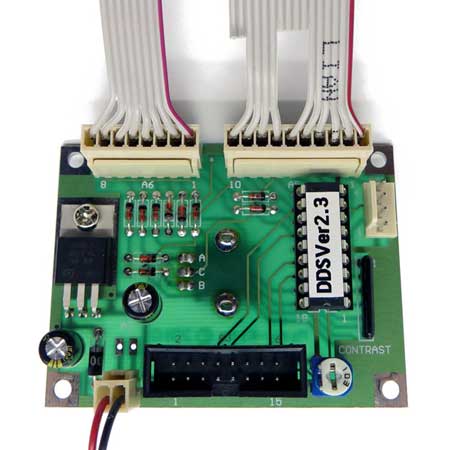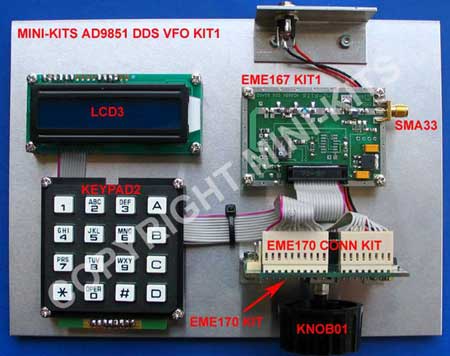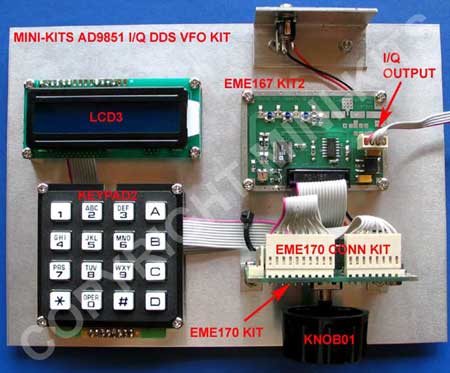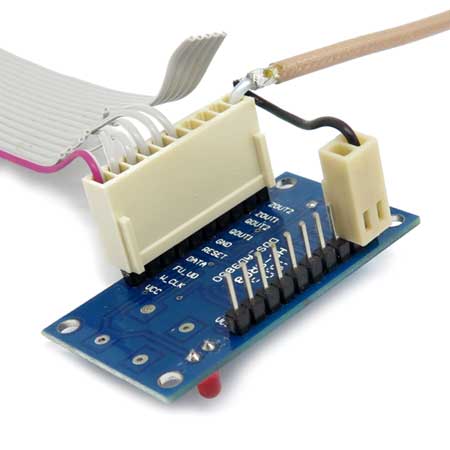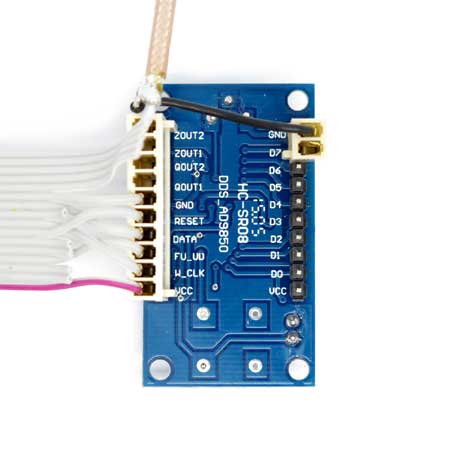AD9851 DDS VFO and I/Q DDS Kits
- DDS-VFO Kit Description:
Updated! June 2022 - I/Q-DDS Kit Description:
- EME170 DDS Controller:
Updated! June 2022 - DDS-VFO Block Diagram Rev2.2:
- DDS-VFO Construction Notes Rev2.3:
- DDS-VFO and I/Q DDS Software:
- SWEEP and RF Power Meter Software:
- Kit Constructors Alert:
- What DDS and Components do I Require:
- Using the I/Q DDS with the Softrock:
- Using the Low cost Chinese AD9850 DDS Module:
- China DDS Block Diagram Rev1.0:
- Kit changes and Updates:
Updated! Sep 2016
The DDS VFO is a complete AD9851 DDS Micro controller with software that can be used as a simple DDS signal generator, or as a VFO, ( variable frequency oscillator ) for a Radio project. Most of the functionality is dependent on the standard software that Mini-Kits supplies with the Kit.
The complete DDS-VFO consists of a number of Kits and components that are available from Mini-Kits. The design consists of three PC board Kits using the Basic AD9851 DDS-VFO Kit, EME167 KIT1, PIC16F648 Controller Kit, EME170 KIT, and the EME188 or EME198 LCD interface Kit. The cheap Chinese AD9850/51 modules can be used with the EME170 Controller, see the DDS-VFO notes for more information.
The DDS Kits are for constructors that have some experience in soldering SMD components, with many of the conventional sized SMD components being easily fitted. This Kit may be a challenge for some with soldering the AD9851 chip to the DDS board, so Mini-Kits does offer a service at extra cost to fit just the chip, and can also can provide fully built Kits. Some wiring is needed for the header connections between the boards, LCD and Keypad. It is suggested that a suitable crimping tool for 2.5mm header pins be used for reliability and to save time.
The maximum frequency that can be used is 70MHz, as this is around a third of the maximum DDS clock frequency for the AD9851 chip. The software allows for a VFO for RX, and a separate VFO for TX that can have the VFO frequencies offset from the displayed frequency. This is useful for receivers or transmitters with an Intermediate Frequency, I/F. So yes it can be used on a receiver that has an e.g. 9MHz I/F by setting the RX display offset by 9MHz. A number of memories frequencies are also available for programming.
DDS chips produce lots of outputs that although many dB under the actual output frequency, can still produce spurious output frequencies when directly fed into a Mixer. For this reason it is suggested that the AD9851 DDS is suitable for simple Radio receiver, or signal generator project. If it is to be used for higher performance applications, then the higher performance 14 bit AD9951 DDS KIT should be used.
The EME167 DDS Board includes an optional reference clock input. A small MMCX socket can be soldered to the board for the external clock input. This is useful when using the DDS board to construct a PLL locked to 10MHz for microwave oscillators.
1/ Be very careful when connecting the EME167 board to the EME170
controller Kit. If you connect the ribbon cable on the IDC headers
the wrong way around the DDS and or PIC controller could be damaged.
Please refer to the DDS VFO Block
diagram that shows from which direction the ribbon cable is
connected between the boards. The Ribbon cable should always be kept
very short and never be routed over the top of the EME167 DDS board.
The IDC header key way should be positioned as per the block diagram
to avoid mistakes.
The I/Q DDS is a complete AD9851 DDS, Micro controller, and basic software to produce a simple I/Q DDS signal generator, that can also be used as a VFO for a simple SDR I/Q Radio project. The I/Q DDS is suitable for the very popular Softrock and is easily connected to the I/Q inputs on the FST3253 switching mixer. Most of the functionality is dependent on the standard software that Mini-Kits supplies with the Kit.
The complete DDS-VFO consists of a number of Kits and components that are available from Mini-Kits. The design consists of two PC board Kits using the Basic AD9851 I/Q DDS Kit, EME167 KIT2, and a PIC16F648 Controller Kit, EME170 KIT.
The DDS Kits are for constructors that have some experience in soldering SMD components, with many of the conventional sized SMD components being easily fitted. This Kit may be a challenge for some with soldering the AD9851 chip to the DDS board, so Mini-Kits does offer a service at extra cost to fit just the chip, and can also can provide fully built Kits. Some wiring is needed for the header connections between the boards, LCD and Keypad. It is suggested that a suitable crimping tool for 2.5mm header pins be used for reliability and to save time.
The maximum frequency that can be used is 35MHz as this is the maximum DDS output of 70MHz divided by 2 to produce the I and Q outputs. The software allows for a VFO for RX, and a separate VFO for TX that can have the VFO frequencies offset from the displayed frequency. This is useful for receivers or transmitters with an Intermediate Frequency, I/F. So yes it can be used on a receiver that has an e.g. 9MHz I/F by setting the RX display offset by 9MHz. This is also especially useful when using with the Power SDR IF or similar software to align the LCD frequency readout with the Power SDR spectrum display. A number of memories frequencies are also available for programming.
There are currently two types of software available to suit the PIC16F648 PIC controller board. The standard software for the DDS-VFO and I/Q DDS Kits is the DDS Ver2.3 software. Mini-Kits also offers software to change the DDS-VFO Kit to a simple sweep generator and RF power meter using the optional SWEEP Ver2.0 software. Please see the SWEEP web page for further information.
Please refer to the DDS Ver2.3 Software documentation for further information.
All Software settings can be changed in the menu setting screens that are displayed on the LCD module. The keypad connected to the EME170 controller board along with the rotary encoder are used to change and memorize the menu settings into the PIC. No reprogramming of the PIC with a computer is required.
Below are the standard specifications for the software supplied by Mini-Kits. The DDS Ver2.3 Source code is available for download on the website for a nominal price to cover the development, and for future software updates.
- Frequency range programmable from a minimum frequency of 1Hz,
to a Maximum output frequency of the DDS-VFO is 70MHz,( Using a
30MHz osc module and DDS x6 multiplier ). Lower frequency RF
output level below 1MHz is lower due to the 10nF coupling
capacitors on the DDS output filter and amplifier.
Maximum output of the I/Q DDS is 35MHz. - TX / RX Display readout can be offset by + 1Hz to 20GHz, ( Suitable for Repeater or I/F Offsets ).
- Memorizes the last VFO or Memory frequency that showed on the LCD display on power up.
- Up to 22 Memory frequencies and settings can be programmed, Depends on what options have been programmed, e.g. RX only, RX/TX use, or RX/TX and Repeater etc )
- Programmed to use a low cost EC12E Mechanical Rotary Encoder.
- Current Ver2 software changed to a Fixed Rate Tuning with Adjustable Step Size 1Hz, 10Hz, 100Hz, 1kHz, 10kHz, 100kHz, 1MHz, 10MHz, 100MHz, 1GHz etc.
- Software fine tuning of the Reference oscillator frequency.
- RIT ( Receive Incremental Tuning ) in RX mode only.
- Programmable for various Reference oscillator frequencies and DDS x1 or x6 Multiplier.
- Divide by 1 Display when used with the EME167 DDS VFO Kit1, or Divide by 2 when used with the EME167 I/Q DDS Kit2, divides the DDS output frequency by 2 producing I/Q outputs, suitable for a IQ mixer.
- Optional Repeater Offset of RX and TX Frequencies.
-
There is no Band switching available in the software, so it can only be used for a single band application. There is also No Mode switching available as this software is designed for a Basic VFO application.
Shown below is the complete DDS VFO Kit1 that is used by Mini-Kits
for testing and development.
Due to the different types of compatible LCD modules and Keypads that we have in stock, we have allowed the option on the Kits web page to select from the different types available.
The Mini-Kits DDS Kits are supplied with genuine Analogue Devices DDS chips, and have the correct 50ohm output and power supply filtering. The low cost Chinese modules commonly seen on auction websites do not use genuine AD9850/51 chips, and can produce much higher output spurs and noise on the RF output.
- 1 x EME167 KIT1 ( AD9851 DDS VFO Kit with a 30MHz oscillator module and 70MHz elliptic low pass filter
- 1 x EME170 KIT ( AD9851 DDS Controller Kit )
- 1 x EME188 or EME189 ( The correct interface is shipped for the LCD module selected )
- 1 x 1 Metre 16 Way Ribbon Cable
- 1 x PIC16F648A ( Programmed with either DDS Ver2.3, or SWEEP Ver 2.0 )
- 1 x LCD4 ( Green/Black 16x2 LCD Module with Backlight )
- 1 x LCD5 ( Blue/White 16x2 LCD Module with Backlight )
- 1 x LCD6 ( Blue/White 16x2 LCD Module with Backlight )
- 1 x KEYPAD4 ( 16 Key Numeric 4x4 matrix )
- 1 x KN-ELMA-020-6420 36mm diameter knob and cap to suit the EC12E 6mm diameter D shaft encoder.
- 1 x KN-ELMA-020-7420 45mm diameter knob and cap to suit the EC12E 6mm diameter D shaft encoder.
Shown below is the complete I/Q DDS VFO Kit that is used by
Mini-Kits for testing and development.
Due to the different types of compatible LCD modules and Keypads that we have in stock, we have allowed the option on the Kits web page to select from the different types available.
The Mini-Kits DDS Kits are supplied with genuine Analogue Devices DDS chips, and have the correct 50ohm output and power supply filtering. The low cost Chinese modules commonly seen on auction websites do not use genuine AD9850/51 chips, and can produce much higher output spurs and noise on the RF output.
- 1 x EME167 KIT2 ( AD9851 IQ-DDS Kit with a 30MHz oscillator module and 70MHz elliptic low pass filter
- 1 x EME170 KIT ( AD9851 DDS Controller Kit )
- 1 x EME188 or EME189 ( The correct interface is shipped for the LCD module selected )
- 1 x 1 Metre 16 Way Ribbon Cable
- 1 x PIC16F648A ( Programmed with DDS Ver2.3 )
- 1 x LCD4 ( Green/Black 16x2 LCD Module with Backlight )
- 1 x LCD5 ( Blue/White 16x2 LCD Module with Backlight )
- 1 x LCD6 ( Blue/White 16x2 LCD Module with Backlight )
- 1 x KEYPAD4 ( 16 Key Numeric 4x4 matrix )
- 1 x KN-ELMA-020-6420 36mm diameter knob and cap to suit the EC12E 6mm diameter D shaft encoder.
- 1 x KN-ELMA-020-7420 45mm diameter knob and cap to suit the EC12E 6mm diameter D shaft encoder.
The low cost Chinese DDS module commonly available can be used in place of the Mini-Kits EME167 DDS board. The EME170 controller and options can be purchased on the website. Expect around -5dBm at 10MHz dropping to around -10dBm at 30MHz. The second harmonic is around -55dBm and you will need to use something like the Mini-Kits Gali-84 Amplifier Kit to increase the RF output to a suitable level for a mixer etc. More information on how these modules are used with the EME170 controller and DDS-VFO software, can be found in the DDS-VFO Construction Notes.
Shown below is what you would require to use the low cost Chinese AD9850 DDS module with the Mini-Kits DDS controller and software.
The RF output is connected to the ZOUT2 connection with the earth braid of the coaxial cable connection with the short black wire to the second GND connection on the module.
Maximum usable output is around 40MHz with the 125MHz clock on the Chinese modules.
- 1 x EME170 KIT ( AD9850/1 DDS Controller Kit )
- 1 x Chinese AD9850 DDS Module
- 1 x 1 Metre 16 Way Ribbon Cable
- 1 x PIC16F648A ( Programmed with DDS Ver2.3 )
- 1 x GALI-84 Amplifier Kit ( to amplify the DDS output to +10dBm )
- 1 x LCD4 ( Green/Black 16x2 LCD Module with Backlight )
- 1 x LCD5 ( Blue/White 16x2 LCD Module with Backlight )
- 1 x LCD6 ( Blue/White 16x2 LCD Module with Backlight )
- 1 x EME188 KIT( To suit the LCD4 and LCD5 Pinout )
- 1 x EME198 KIT( To suit the LCD6 Pinout )
- 1 x KEYPAD4 ( 16 Key Numeric 4x4 matrix )
- 1 x KN-ELMA-020-6420 36mm diameter knob and cap to suit the EC12E 6mm diameter D shaft encoder.
- 1 x KN-ELMA-020-7420 45mm diameter knob and cap to suit the EC12E 6mm diameter D shaft encoder.
Tony Parkes development of the Softrock should be honored by the ARRL as having one of the greatest effects ever on Ham Radio and Home brew worldwide. Daily, new SDR designs and web pages appear on the Internet due to the very high popularity of simple SDR Radio designs. The Softrock Kits are mainly simple mono band designs to keep costs low, through to more complex multi band designs. Most have very limited coverage on most bands and generally don't have full HF band coverage.
Mini-Kits has released the AD9851 I/Q DDS VFO Kit that can be easily connected to the Softrock Kits, and allows coverage of the complete HF bands to 35MHz. The software has been kept simple, and the description of what it can do can be read.
1. Disconnect the original clock signals to the FST3253 mixer
2. Disconnect the X1 or X2 crystals from the onboard oscillator by remove the shorting link on JP2 used to select crystals.
3. Using a short length of 4 way ribbon cable from the
4. You can continue to use your favorite sound card software like Power SDR IF Stage, or similar for demodulating the I and Q signals.
1/ Erratic frequency jumping when rotating the encoder can be due to the low cost EC12E encoders mechanical alignment due to manufacturing. Some intermittent jumping is unavoidable, and a suitable control knob should be used to more evenly distribute the force on the encoders shaft. If the problem is very bad then the only solution is to replace the encoder.
2/ Problems with the DDS outputting the incorrect frequency intermittently, can be due to the clock logic level into the DDS being a greater level compared to the DDS serial data. Check that the clock level to the DDS clock input is less than 5v p-p, and reduce it is required by adjusting the 220ohm resistor on the clock input.
3/ Problems with the display or keypad not working correctly, are normally due to wiring problems with the ribbon cables. Carefully check the cables using the block diagram carefully.
4/ No or very low RF output is normally the GALI-84 that may have failed due to heat or accidental shorting to ground. If you have this problem with a New Kit, then you may not have followed the Kit notes and not aligned the device leads causing a short to ground.
1/ Any problems with this Kit are generally the same as the DDS-VFO Kit.

